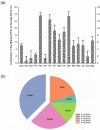Spatial Distribution, Potential Sources, and Health Risk of Polycyclic Aromatic Hydrocarbons (PAHs) in the Surface Soils under Different Land-Use Covers of Shanxi Province, North China
- PMID: 36231245
- PMCID: PMC9565183
- DOI: 10.3390/ijerph191911949
Spatial Distribution, Potential Sources, and Health Risk of Polycyclic Aromatic Hydrocarbons (PAHs) in the Surface Soils under Different Land-Use Covers of Shanxi Province, North China
Abstract
Polycyclic aromatic hydrocarbons (PAHs) are widespread in the environment and pose a serious threat to the soil ecosystem. In order to better understand the health risks for residents exposed to PAH-contaminated soil, 173 surface soil samples were collected in Shanxi Province, China, to detect the levels of 16 priority PAHs. The spatial distribution patterns of PAHs were explored using interpolation and spatial clustering analysis, and the probable sources of soil PAHs were identified for different land-use covers. The results indicate that the soil Σ16 PAH concentration ranged from 22.12 to 1337.82 ng g-1, with a mean of 224.21 ng g-1. The soils were weakly to moderately contaminated by high molecular weight PAHs (3-5 ring) and the Taiyuan-Linfen Basin was the most polluted areas. In addition, the concentration of soil PAHs on construction land was higher than that on other land-use covers. Key sources of soil PAHs were related to industrial activities dominated by coal burning, coking, and heavy traffic. Based on the exposure risk assessment of PAHs, more than 10% of the area was revealed to be likely to suffer from high carcinogenic risks for children. The study maps the high-risk distribution of soil PAHs in Shanxi Province and provides PAH pollution reduction strategies for policy makers to prevent adverse health risks to residents.
Keywords: GIS; PAHs; carcinogenic risk; land-use management; spatial pattern.
Conflict of interest statement
The authors declare that they have no known competing financial interests or personal relationships that could influence the work reported in this paper.
Figures








References
Publication types
MeSH terms
Substances
LinkOut - more resources
Full Text Sources

